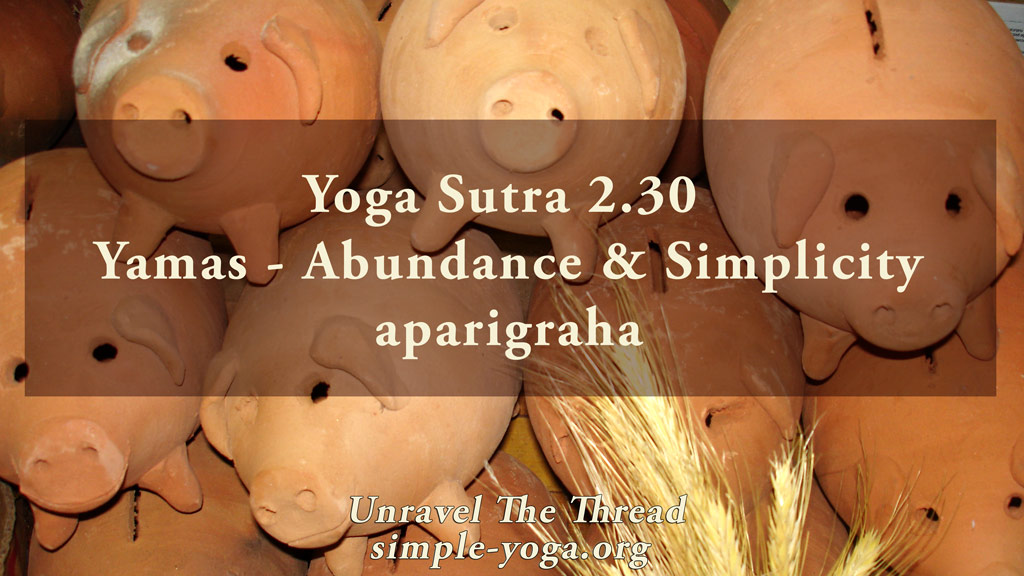
2:30 Yamas: Abundance and simplicity – aparigraha
October 13, 2020
2.32 Niyamas: Contentment – samtosha
November 2, 2020
2:30 Yamas: Abundance and simplicity – aparigraha
October 13, 2020
2.32 Niyamas: Contentment – samtosha
November 2, 20202.32 Niyamas: Clarity – shaucha


2.32 The niyamas, wise ways for releasing struggle, are: Clarity (shaucha), Contentment (santosha), Enthusiasm (tapas), Wisdom (svadhyaya) and Humility (ishvara pranidhana).
One way of seeing the yamas and the niyamas is as complementary practices, the yamas presenting the Don’ts and the niyamas suggesting the Dos. As mentioned in the section about the yamas, to facilitate their practice, it makes sense to frame both yamas and niyamas in positive terms. In other words, rather than seeing the yamas as a command not to do something, it is easier to implement them when you see them as guidelines for mindful participation in your life. Another traditional way of seeing the yamas and niyamas is as the yamas being an outward practice, ways of regulating your interactions and relationships with the world around you. Conversely, the niyamas can be understood as an inward practice, or how you modulate your relationship to yourself to create balance within. Moreover, the yamas and niyamas can be interpreted as common-sense guidelines for managing your vital energy. These wise ways offered by the yamas and the niyamas are the foundation for yoga. They are the stepping stones for creating integrated harmony within and without. While the yamas offer ways to remove strain, the niyamas provide a path to care for your inner garden through intelligently releasing sources of struggle. Both the yamas and the niyamas are gradual processes of aligning external actions with your inner peace and harmony.
CLARITY – SHAUCHA
In Sanskrit, the meanings of shaucha include, cleanliness, clarity, purification, purity of mind, integrity and honesty. Shaucha is to cultivate clarity and purity in mind, body, emotions and intentions. Bringing this niyama into practice asks you to inquire into your intentions to discern the reasons that move you to choose one option over another and to act in one way instead of another. It is fair to say that purity of intention and action sow the seeds that blossom into clarity. Remember that in sutra 1.33 Patañjali provides a path for purifying mind, body and emotions by practicing friendliness, compassion, inspiration and equanimity. One way to explore purity is to contemplate the notion of conscience. Is it possible that you have an internal compass indicating with subtlety the choices leading you to act with purity? Are your thoughts, emotions, actions and interactions grounded in pure intentions? Does it feel different to listen for inner guidance that is independent from your likes and dislikes? Is the clarity to distinguish between being guided by your preferences and being guided by your conscience one way to embody the discriminative awareness (viveka) mentioned in verses 2.15, 2.25, 2.26 and 2.27? Can this be what Patañjali is talking about also in sutras 2.4 and 2.5 about ignorance (avidya) leading us to confuse what is impure for pure? In your daily life are there any sensations, thoughts and emotions that indicate you are aligning with purity in your choices, actions and interactions? When you pay attention to the results of your actions is there anything in the results indicating the purity of your motivation?
You may also approach application of this verse by asking, “How do I know that my intentions are clear?” “How do my actions embody clarity?” When you sit in silence, is your internal environment clear? Is it possible that an uncluttered space may contribute to greater internal clarity? To what extent do your choices of food, relationships, work, hobbies and entertainment contribute to your clarity? Finally, to what extent do the effects of your actions serve as testimony of your clarity, or lack thereof? A mantra that can be helpful, I CHOOSE CLARITY.
As usual, one more way of exploring the meaning of this sutra is by chanting it.
You can choose to chant it in its traditional form with some of the words coming together:
2.32 śauca saṃtoṣa tapaḥ svādhyāyeśvarapraṇidhānāni niyamāḥ
शौच संतोष तपः स्वाध्यायेश्वरप्रणिधानानि नियमाः ॥३२॥
Another option is to chant each word in the sutra individually:
- śauca
- saṃtoṣa
- tapaḥ
- sva
- adhyāya
- iśvara
- praṇidhānāni
- niyamāḥ
If you prefer, you may listen to the podcast:
Unravel the thread is now available as a book!
If you find Simple-Yoga.org and Unravel the thread useful, consider supporting my labor with a donation, you may also donate using PayPal or Venmo. Thank you!